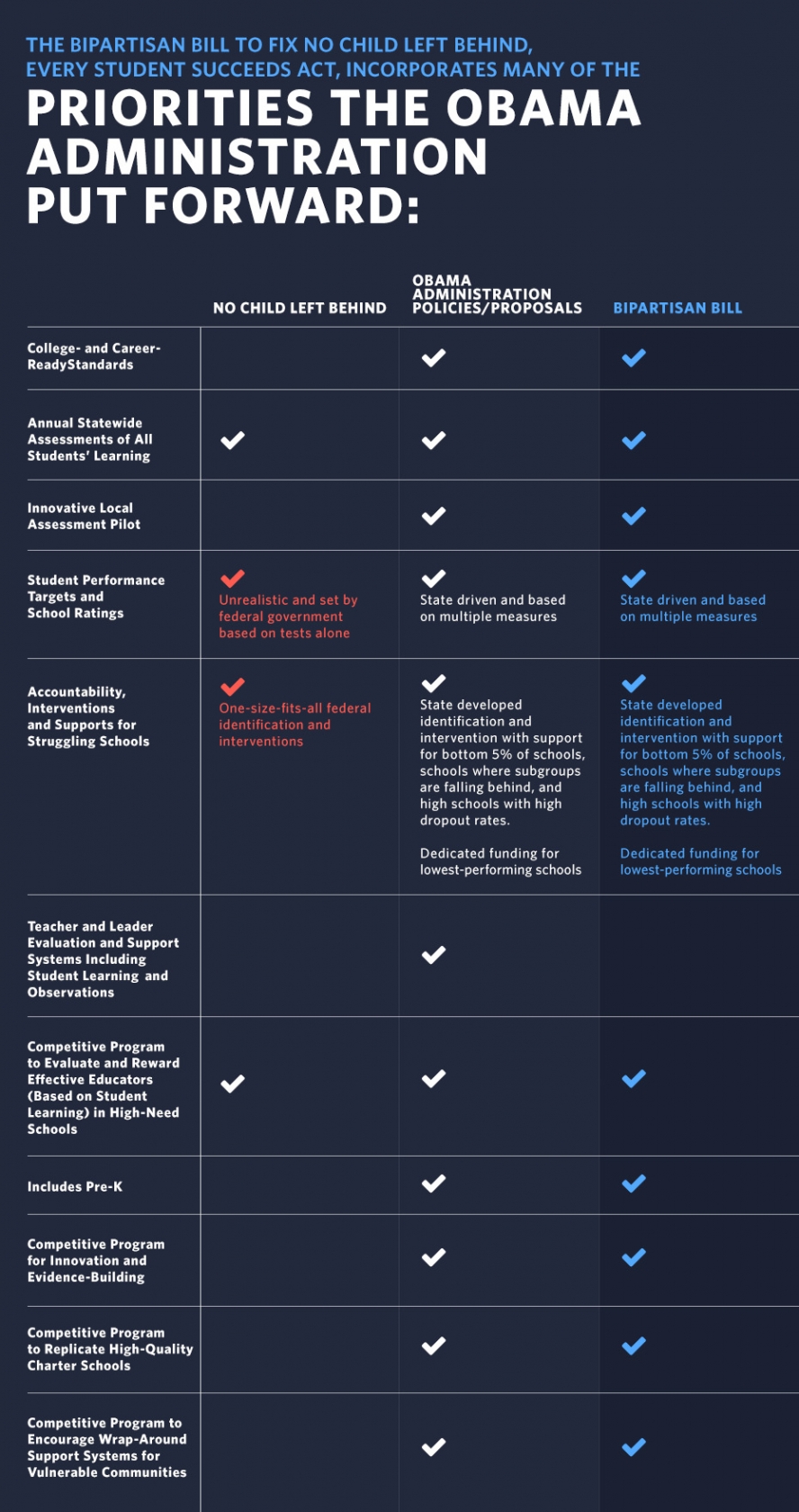
Last Wednesday, the House of Representatives passed the Every Student Succeeds Act (ESSA) to fix No Child Left Behind. The Obama administration is calling on the Senate to move the legislation quickly to the President’s desk for him to sign.
As Secretary Arne Duncan said earlier this week, No Child Left Behind has long been broken. Since the beginning of his time in office, President Obama has joined educators and families calling on Congress to fix this outdated law.
To help you understand just how ESSA improves on the one-size-fits-all mandates on our schools, and fits right in with President Obama’s policies, check out this side-by-side comparison:

I also want to take this opportunity to answer some of the most common questions we’ve been hearing from you on how ESSA can help American families, students, and schools:
Does this bill ensure high standards?
Yes. The bill affirms the path taken by 48 states and the District of Columbia to hold all students to challenging academic content standards that will prepare them to graduate from high school prepared for success in college and the workforce.
Does this bill move towards a smarter, more balanced approach to testing?
Yes. As President Obama has called for, the bill encourages a smarter approach to testing by moving away from a sole focus on standardized tests to drive decisions around the quality of schools. It also does so by allowing for the use of multiple measures of student learning and progress, along with other indicators of student success to make school accountability decisions. It also includes provisions consistent with the Administration’s principles around reducing the amount of classroom time spent on standardized testing, including support for state efforts to audit and streamline their current assessment systems. At the same time, the bill maintains important statewide assessments to ensure that teachers and parents can mark the progress and performance of their children every year, from third to eighth grade and once in high school.
Does the bill create rigorous accountability for all students?
Yes. Consistent with the Administration’s proposals and policies, the bill builds on the federal-state partnerships in place in over 40 states to require meaningful goals for the progress of all students, and to ensure that every student subgroup makes gains toward college and career-readiness. States must set ambitious targets to close student achievement and graduation rate gaps among subgroups of students in order to meet their goals. In schools where too many students consistently fail to reach the goals and other indicators set by the state, school districts will ensure they receive tailored interventions and supports proportionate to the needs of those schools and the students they serve.
Does the bill have competitive programs to spur innovative, replicate high quality charter schools and encourage support systems for vulnerable communities?
Yes. The bill contains competitive programs modeled after many the Administration has created and supported for years. These include a program to develop, refine, and replicate innovative and ambitious reforms to close the achievement gap in America’s schools, similar to the Administration’s existing Investing in Innovation (i3) program; to leverage resources to address the significant challenges faced by students and families living in high-poverty communities through the Promise Neighborhoods effort, supporting a full continuum of services from early learning through college; and to expand support for high-performing public charter schools for high-need students.
Does the bill include harmful portability provisions?
No. The bill rejects so-called “portability” provisions in the original House-passed bill that would have allowed states to shift federal funds away from the schools that need them most.
Does the bill contain additional preschool slots?
Yes. The bill expands access to high-quality, state-funded preschool for children from low- and moderate-income families, building from the Administration’s Preschool Development Grants program. This is a major win for our youngest children and for American families.


